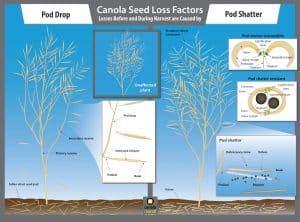Seed decisions may require some extra planning for 2022
We hear the discussions about canola seed availability for 2022. This is a good time to have a conversation with seed suppliers. Ask about:
- availability of clubroot-resistant cultivars, because we’d really like you to grow them.
- insecticide seed treatment with improved flea beetle protection.
- the level of pod shatter resistance. (See graphic below. Click to enlarge.)
- trying a few different cultivars for 2022. This may be the year for a “right cultivar for each field” approach.
The Canola Performance Trials website compares cultivar performance based on small plot and field scale trials. While 2021 data is not yet posted, data from 2020 is based on the more “normal” environmental conditions that occurred in 2020. The Canola Variety Selection Guide CPT booklet from 2017 has tips on gathering and analyzing data, and choosing cultivars for each field.

A great time for soil tests
Fall soil samples taken after the soil has cooled to less than 10°C will provide results that more accurately quantify nutrient levels next spring. This will help with planning for 2022. With lower yields in 2021, soil nutrient reserves may be higher than usual. Agronomists and farmers can use these soil test results to have a conversation about right rates and other 4R practices that will improve the return on investment for fertilizer. When choosing a soil testing lab, make sure it’s an accredited one that uses soil test methods suitable for your soil type. Choose one soil lab and stick with it for consistency over time. For more on soil testing, including “Consistency of soil test lab recommendations” and “Soil analysis methods”, please read the Canola Encyclopedia.
- How much fertilizer does canola need?
- Canola Research Hub: Research behind suitable fertilizer source choices
- Canola Digest article: How to increase yield with fertilizer
Turn bins on cool days
With higher canola prices and lower yields, canola in storage is more valuable than ever. These cooler days are a good time to give all bins a check heading into winter. The best method to check for spoilage, even for bins with monitoring cables, is to remove about a third of the bin. Put it on a truck or move it to another bin. This disrupts the moisture cycle and helps to stop any heating or spoilage that may have begun in the central core. Feel and smell canola as it comes out of the bin. Check for visual abnormalities such as sweating. Run another moisture and temperature test. If canola has any hint of spoilage, consider cycling the whole bin. Factors that increase canola storage risk. To learn the impacts of other storage risk factors, check out this Canola Research Hub blog.
What is your herbicide carryover situation?
Herbicide carryover could present a risk to planned crop rotations for 2022. Residual herbicides need (1) soil moisture at the surface, (2) warm soil temperatures, and (3) time for breakdown to occur as expected. Areas with very low moisture accumulation through June, July and August 2021 will be at highest risk for herbicide carryover into 2022. Consider this when making crop rotation decisions. Please reach out to herbicide manufacturers for carryover risks for all products applied in 2021. The Canola Encyclopedia describes factors that slow the pace of herbicide breakdown. SaskCanola cooperated on a podcast with Clark Brenzil looking at the herbicide residue situation from a whole-rotation perspective. SaskCanola also has a publication Herbicide Carryover – Risks and Considerations.
